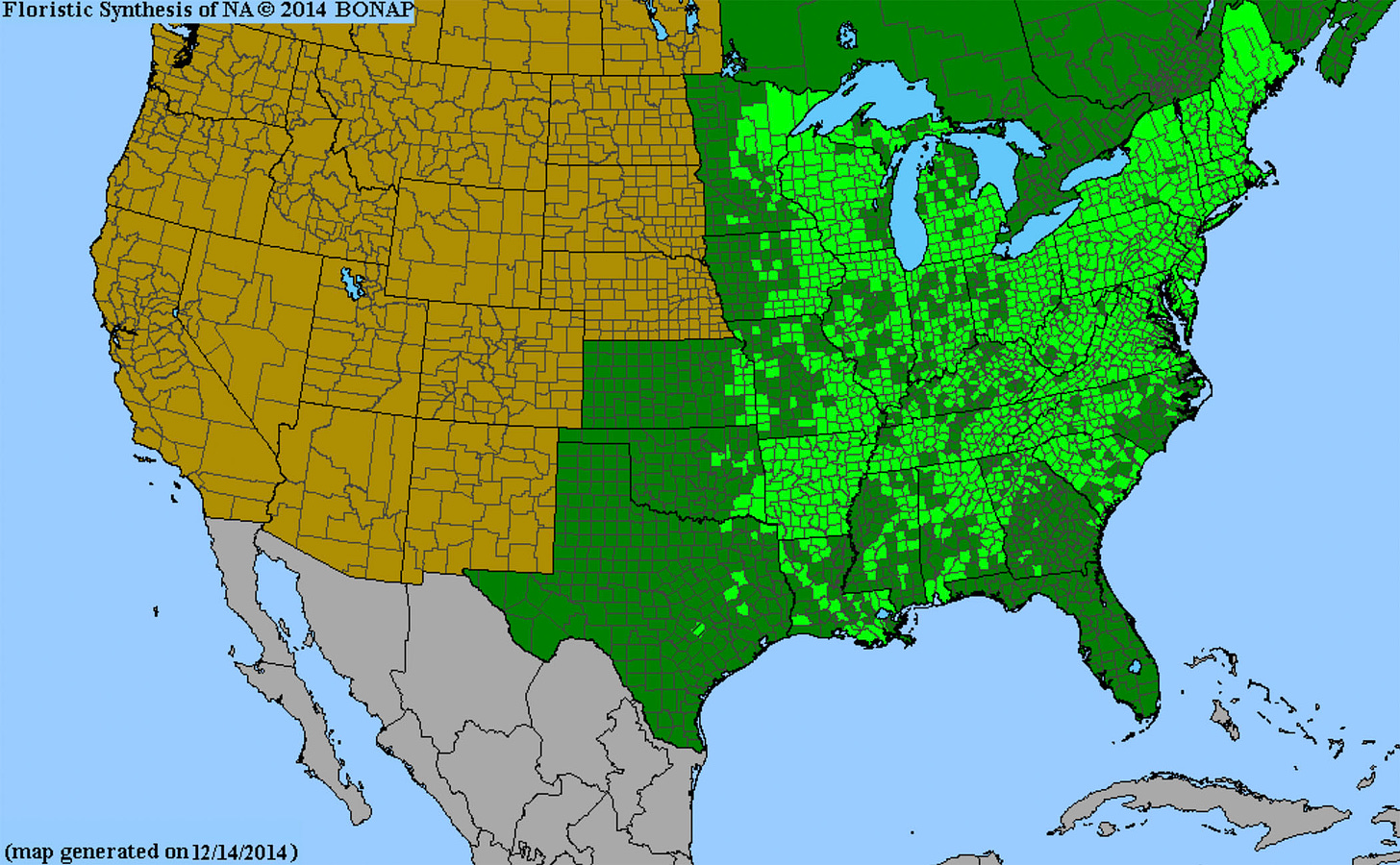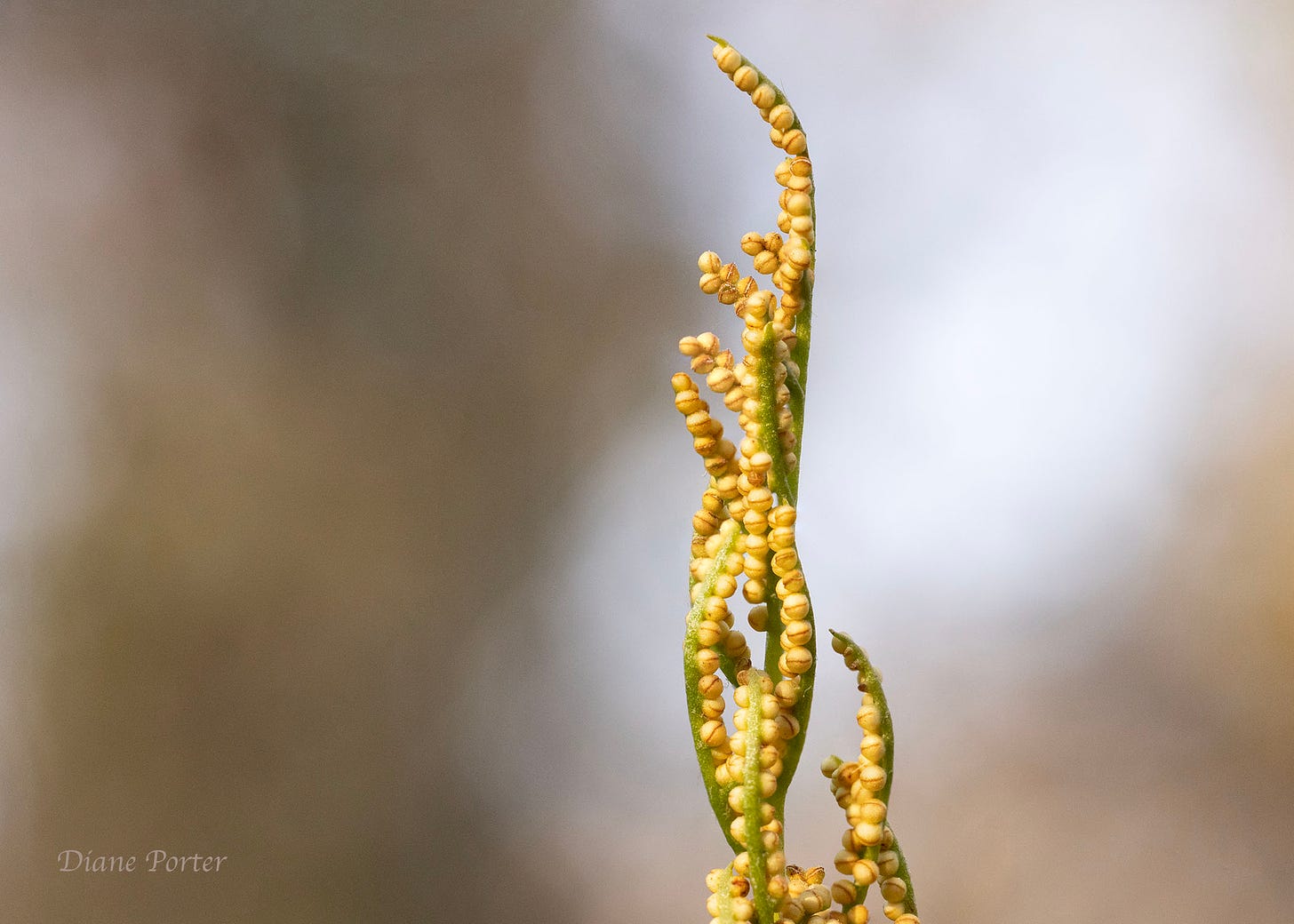
Discover more from My Gaia
Rising above the dead leaves and grasses, a golden wand swept upward in the woods. It could easily be overlooked. It made me think of some slender animal, unfamiliar, perhaps mythical, standing on its hind legs to look in wonder at where it had found itself.
It was less than a foot tall, festooned with delicate chains of gold. I knelt for a closer look. The gold chains resolved into lines of tiny spheres — like miniature grapes.
However, they are not fruits. The golden balls contain spores, the microscopic particles that new ferns come from.
Among several kinds of grape ferns, this particular species is known as Cutleaf Grapefern. It grows along a wooded path near my house in southeast Iowa. A single green leaf comes up in spring. In fall, the stalk of golden balls appears. That’s usually when I spot the fern.
Only two fronds
A mature Cutleaf Grapefern has exactly two leaves. Or fronds, as fern leaves are often called.
The two fronds are about the same size, but they are different. They don’t even look related.
The leafy frond
One frond emerges in spring, looking like a clump of light green leaves close to the ground. Actually, it is all one frilly leaf, growing on a single stem. It is called the sterile frond, because it has no reproductive structures. It performs photosynthesis, to nourish the entire plant. Young Cutleaf Grapeferns may have only this one kind of frond.
The fertile frond
The other frond, which emerges in late summer or fall, bears the golden orbs containing spores. It is the fertile frond, responsible for reproduction. In fall we find the plants with the two kinds of fronds visible at the same time.
Side by side
The two fronds of the one fern grow out of the same spot on the root, separating just before they reach the surface of the soil.
Still on my knees, I blew lightly on the golden fertile frond, and a slight puff of fog wafted away from it. The spores!
OK, I couldn’t resist. I had to snip a piece from the fertile frond and take it home to the microscope.

Sporangia and spores
Now, under the microscope, I got a better look at the golden spheres. They are called sporangia. They hold the spores. (Sporangium, Latin, means spore vessel.) A sporangium is about one millimeter in diameter.
Some showed a sort of crease around the equator. One sporangium was splitting along the crease. I zoomed in on it and gave the gentlest poke. The crease opened and revealed what must have been thousands of spores.



Ferns make no flowers. Ferns generate no seeds. They reproduce by means of spores, which they release into the air.
Two stages of life
Each spore is microscopic, comprised of only one cell. Virtually weightless, it rides the air away from the fertile frond of its parent.
First stage: the gametophyte
If the spore of a Cutleaf Grapefern lands in a suitably shady, damp location, it grows into a fingernail-sized plant that lives submerged underground. It doesn’t look like the fern we normally see. This part of the fern’s life cycle is known as the gametophyte stage.
No food comes along with the spore, and it has no access to sunlight or photosynthesis. It lives on nutrition supplied by soil fungi as it slowly grows. Maturation can take from two to ten years.
Once mature, it produces both eggs and sperm. Rain water carries the sperm to the eggs, and fertilization takes place.
Second stage: the sporophyte
The fertilized egg is a new individual. It develops roots. It emerges above ground, looking the way we often think of ferns. This form of the fern is known as the sporophyte stage.
Fern life plan
The fern lives by switching between generations of the two distinct life stages: gametophyte and sporophyte. Each generation produces the other, in a cycle. Such a life plan is called alternation of generations. It’s characteristic of all ferns.
Range map
Cutleaf Grapefern is widely found throughout eastern North America. I have seen it in sparse woodlands, but it is also found in grassy areas and even deep forest.

The names
Common names: Cutleaf Grapefern, Dissected Grapefern.
It’s described as “Cutleaf” because it appears as if cut with scissors into frilly designs.
The name “Grapefern” was inspired by the grapey appearance of the sporangia.
Scientific names: Sceptridium dissectum.
Botrychium dissectum used to be its name, but that has been changed on the basis of new understanding of the evolutionary relationships between different ferns. The older name still remains in many books and online sources.
The first part of the scientific name, Sceptridium, comes from a Greek word meaning scepter, from the upright, curving shape of the fertile frond.
The second part of the scientific name, dissectum to refers leafy frond’s ruffled appearance, which looks as if it’s been cut many times.
Similar species: There are about ten species of Sceptridium ferns in North America, with at least one growing in every state save Nebraska. All have sporangia similar to Cutleaf Grapefern.

















A fascinating article. I learned a lot. Appreciate your microscope detailed views especially.
Fascinating information!! Thank you Diane for sharing and doing the research, so we all learn!! Your posts are enjoyable to read! What a fun way to learn about our amazing natural world we share with so many plants and critters!